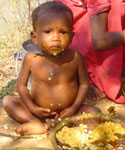India accounts for 57 million of the world’s 146 million malnourished children.
It has the same rate of malnutrition as Ethiopia (47 per cent) and Nepal and Bangladesh (48 per cent). This is in stark contrast with the figures for China (eight per cent), Thailand (18) and even Afghanistan (39), according to a global report released by the United Nations Children’s Fund here on Wednesday.
At the current rate of progress, the millennium development goal to halve child hunger by 2015 will not be reached till 2025, says the document, “Progress for Children: A Report Card on Nutrition, 2006.”
Only slight decline
The proportion of underweight children in developing countries has declined only slightly in the past 15 years — falling just 5 percentage points since 1990. One in four children under five in developing countries is underweight (27 per cent of 146 million). Nearly half of them live in India, Bangladesh and Pakistan, accounting for the death of 5.6 million children under five every year.
Each year 6,00,000 under-5 child deaths could be averted in India if simple health interventions along with correct feeding practices were universally applied. One out of every three adult women is underweight and therefore at risk of giving birth to low-weight babies.
Girls worse off
Severe malnutrition is more frequent among girls (19.1 per cent) than boys (16.9 per cent). While most infants in India are initially breastfed, only 37 per cent children are exclusively breastfed for four months.
Malnutrition rates among children of 0-3 years vary greatly across States, from Madhya Pradesh (55.1 per cent), Bihar (54.4), Orissa (54.4), Uttar Pradesh (51.7) and Rajasthan (50.6) to Goa (28.6), Manipur (27.5 ) and Kerala (26.9).
The report suggests half of all children in India under three are underweight, a quarter of all children are born with low weight, and three quarters of under-three children and half of adult women are anaemic. Malnutrition is not only about hunger but also because of early marriage and consequently early motherhood as also lack of sanitation.
Insufficient quantity of food is less to blame for child under-nutrition than poor food quality and safety, and women’s low social status.
Calling upon the Government to improve pre and post-natal care, the report suggests that malnutrition can be reduced only by ensuring that newborns are given colostrum, infants are exclusively breastfed for six months and adequate complementary foods are given three to five times a day after that. Children should be brought to health centres for immunisation and micronutrient supplementation.

